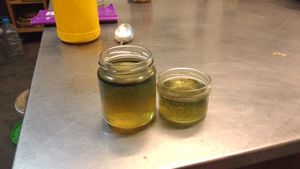Elektrolizer
el primer dia de uso de el dispositivo electrolizador petamos el fusible, se le cambio y puso uno nuevo y trassss de nuevo, lo tragimos a Pech y al abrirlo tachannnnn solo lleva un puente(graez) de diodos que hace la FUNCIÓN DE RETIFICAR LA CORRIENTE ALTERNA de una fase EN CONTINUA, un interruptor una resistencia, un led y cuatro electrodos.
al ver que se petaba de nuevo el fusible intuí que el retificador se abría petado y efectivamente, había un corto que lo petaba to ! !
pues nada esperando para comprar otro puente, noi tenemos a mano ninguno de esas caracteristicas...
HH ME OLVIDO DE LO MÁS IMPORTANTE, SEGÚN LA TABLA DE EL DISPOSITIVO, SI EL AGUIA SE TORNA COLOR VERDE, CONTIENE MERCURIO Y ARSÉNICO ,.,.,.,. QUE FUERTE NO ???
antes cuando no habia abierto el dispositivo teníamos ciertas dudas a cerca de la fiabilidad de el mismo, pero sabiendo que simplemente corrige la corriente alterna a continua para hacer el proceso de electrohidrólisis y lisiar moléculas de otras ustancias que habitan el agua, todo me parece más real ,.,.,.,.
ya estoy viendo un posible producto a realizar con la impresora 3d y electrodos
bueno parece que el tema de los electrodos y las membranas no sea tan tribial como lo estaba considerando :
Electrolysis is an electrochemical process in which electrical energy is the driving force of chemical reactions. Substances are decomposed, by passing a current through them. The first observation of this phenomenon was recorded in 1789. Nicholson and Carlisle were the first who developed this technique back in 1800 and by the beginning of the 20 th
century there were already 400 industrial water electrolysis units in use.
As mentioned before, water is decomposed to hydrogen and oxygen, by passing a current through it in the presence of suitable substances, called electrolytes. Electric current causes positively charged hydrogen ions to migrate to the negatively charged cathode, where a reduction takes pl ace in order to form hydrogen atoms. The atoms formed then combine to form gaseous hydrogen molecules (H 2 ). On the other hand, oxygen is formed at the other electrode (the positively charged anode). The stoichiometry of the r eaction is two volumes of hydrogen to one volume of oxygen. The most important part of the construction of electrolysis units is to use adequate electrodes to avoid unwanted reactions, which produce impurities in the hydrogen gas. Another necessary com ponent of such a unit is a separating membrane that allows the passage of ions, or electrons and not oxygen, or hydrogen atoms. This membrane allows the gases to be kept separate in order to avoid the risk of an explosive mixture being formed in the electrolysis unit.
